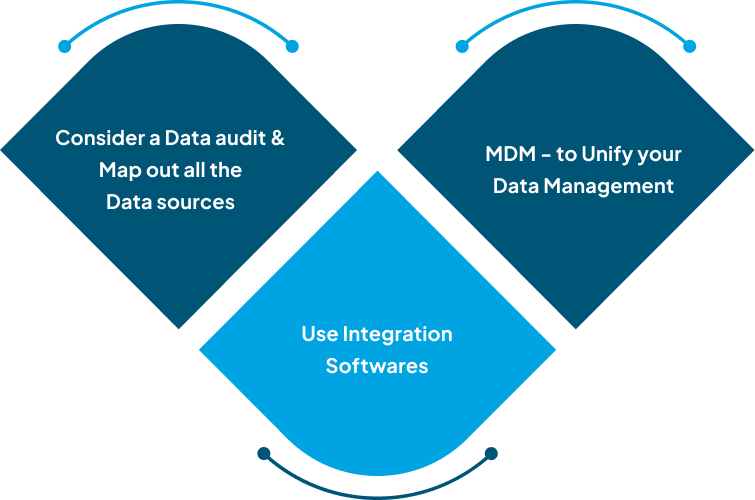Quick Summary:
Organizations often face challenges due to data silos, which hinder information flow and decision-making processes. These silos arise from factors like organizational structure, communication gaps, and incompatible systems. The costs associated with data silos include operational inefficiencies and missed opportunities for synergy.
Organizations also face challenges such as duplicated processes, inconsistencies in data quality, and difficulties in retrieving and integrating data from disparate sources. To break down data silos, organizations can conduct data audits, invest in integration software, and implement Master Data Management (MDM) solutions.
Companies like Innovatics play a key role in preventing and dismantling data silos by implementing comprehensive
When it comes to making decisions, intuition is useful but not always a way to go. In today’s competitive business world smart and data backed decisions are essential to be relied on. There is a lot of data in an organization— both quantitative and qualitative — captured in business tools and integrations over which you can rely to derive transparency & efficiency within your organization. Let’s understand a little deep.!How do you determine what’s best for your organization?
What is a Data Silos?

Data silos represent a common challenge in today’s business scenarios, blocking smooth information flow and hammering down smart decision making processes. In general terms, a data silo refers to a segregated repository of information within an organization that is isolated from other databases, applications, or systems. This isolation restricts the efficient sharing and accessibility of data across different departments, leading to operational inefficiencies and missed opportunities for synergy.
What causes Data Silos?
-
Organizational Structure
Also known as “Departmentalization” When an organization is structured in a way that encourages departmental autonomy, each department may develop its own data management practices and systems, leading to isolated data silos.
-
Communication and Collaboration Gaps
Inadequate communication channels between departments can result in a lack of awareness regarding data sharing practices and standards.
Also when departments operate independently with minimal collaboration, there is a higher likelihood of data silos developing due to the absence of cross-functional data integration initiatives. -
Incompatible Systems
The use of diverse data formats, standards, and coding languages across different departments or systems can impede seamless data integration, fostering the creation of data silos.
-
Strategic Oversight
Without a comprehensive data management strategy, organizations may fail to address the long-term implications of data fragmentation, inadvertently fostering the development of data silos.
-
Resistance to Change
Organizational cultures that resist change may hinder efforts to implement integrated data solutions, allowing data silos to persist.
What is the cost of Data Silos?
The costs associated with data silos integration in an organization encompass various facets, including operational inefficiencies, resource fragmentation, and missed opportunities. Operationally, the manual handling of data within silos introduces labor-intensive processes, resulting in increased time delays and decreased operational speed.
How to break down Data Silos?

-
Consider a data audit & map out all the data sources
A strategy and technological approach is required to break down data silos inside an organization. Begin with a thorough data audit to identify current data silos and map out data sources, structures, and connections. This preliminary stage gives insights for strategic planning and builds the platform for further integration initiatives.
-
Use Integration Softwares
Organizations can also invest in modern integration solutions & middleware to connect diverse systems effortlessly. Using APIs and data integration platforms accelerates data flow, breaking down departmental barriers and creating a more coherent data environment.
-
MDM – to unify your Data management
Implement Master Data Management (MDM) solutions to create a single, authoritative source for critical data entities. MDM ensures data consistency and accuracy, mitigating issues related to redundancy and inconsistency.
What challenges does an organization face due to data silos?
- Data silos solutions hinder the ability to make informed decisions by limiting access to a comprehensive view of information
- Managing Data silos can result in duplicated processes and human labor. Data collection and storage may be duplicated across departments, resulting in inefficiencies, greater workload, and higher operating expenses.
- Data silos and business intelligence contribute to inconsistencies in data quality and accuracy. Without standardized processes and governance, different departments may have varying data standards, leading to discrepancies and errors in reporting and analysis.
- Retrieving and integrating data from disparate sources can be time-consuming. This delay in accessing critical information can impact the organization’s ability to respond quickly to market changes and make timely decisions.
- Siloed data can lead to inconsistencies in customer information. This impacts the ability to provide personalized and consistent experiences, potentially leading to customer dissatisfaction and lost opportunities.
How Innovatics can prevent data silos in organization from causing problems in your organization?
Innovatics- An advanced data analytics company can play a pivotal role in dismantling data silos strategies and harnessing the full potential of an organization’s data. We leverage advanced analytics tools, such a company can implement comprehensive data integration strategies to break down silos effectively. Our experienced data silos team also uses advanced algorithms and data processing techniques, these analytics solutions can unify disparate datasets, irrespective of their formats or locations.
We also specialize in developing custom dashboards, reporting tools, and data visualization solutions that facilitate user-friendly access to integrated data. This empowers decision-makers with a comprehensive and real-time view of the organization’s data landscape, enhancing the speed and accuracy of decision-making processes.
In terms of governance, Innovatics can implement robust metadata management and data lineage tracking. This provides organizations with a clear understanding of data ownership, quality standards, and access protocols, establishing a foundation for sustained data integration.
Conclusion
An advanced data analytics company like Innovatics offers technical experience as well as inventive ideas to the table, assisting firms in overcoming the obstacles created by data silos strategies. These businesses contribute to the building of a unified data ecosystem by uncovering new insights, enhancing operational efficiency, and helping enterprises to make data-driven choices with confidence.












Neil Taylor
October 30, 2023Meet Neil Taylor, a seasoned tech expert with a profound understanding of Artificial Intelligence (AI), Machine Learning (ML), and Data Analytics. With extensive domain expertise, Neil Taylor has established themselves as a thought leader in the ever-evolving landscape of technology. Their insightful blog posts delve into the intricacies of AI, ML, and Data Analytics, offering valuable insights and practical guidance to readers navigating these complex domains.
Drawing from years of hands-on experience and a deep passion for innovation, Neil Taylor brings a unique perspective to the table, making their blog an indispensable resource for tech enthusiasts, industry professionals, and aspiring data scientists alike. Dive into Neil Taylor’s world of expertise and embark on a journey of discovery in the realm of cutting-edge technology.